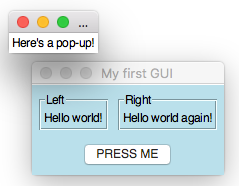The power of WITH
Using ContextManagers to make GUIs even easier.
One thing I really wanted to get into appJar, was some indentation - I wanted the code for the GUI to look more like the actual GUI.
I also wanted to simplify the creation of containers, and even the GUI itself.
with gui("My first GUI") as app:
app.addLabel("lab", "Hello world!")
That's it - 2 lines to create a GUI.
If you want to add containers, it's the same process:

from appJar import gui
with gui("My first GUI") as app:
app.setBg("lightblue")
with app.labelFrame("Left"):
app.addLabel("left", "Hello world!")
with app.labelFrame("Right", row=0, column=1):
app.addLabel("right", "Hello world again!")
app.addNamedButton("PRESS ME", "Pop-up", app.showSubWindow, colspan=2)
with app.subWindow("Pop-up"):
app.addLabel("popLab", "Here's a pop-up!")
And, that's all there is to it - this feature is available on all containers, and I think it's going to make things a lot simpler!
The old start/stop functions all still exist, so there is no need to use the with command. But if you prefer this method, it's there.
An added bonus, is that the same syntax works for starting a container or opening a container!
Available Containers
from appJar import gui
def press(btn):
with app.page(windowTitle="pages", pageNumber=1):
app.addLabel("newLab", "New Label")
with gui() as app:
app.setSize(250, 300)
with app.pagedWindow("pages"):
with app.page():
app.addLabel("l1", "Page One")
app.addButton("PRESS", press)
with app.page():
app.addLabel("l2", "Page Two")
with app.page():
app.addLabel("l3", "Page Three")
The following can all be used in the same format to start or open a container:
Have a look on the containers page for usage information.
.frame(title).frameStack(title).labelFrame(title, hideTitle=False).toggleFrame(title).scrollPane(title).tabbedFrame(title).tab(title, tabTitle=None).panedFrame(title, vertical=False).pagedWindow(title).page(windowTitle, pageNumber)- NB. only provide the named parameters if opening a page.subWindow(name, title=None, modal=False, blocking=False, transient=False, grouped=True)
If you're playing with ttk, you can try:
.notebook(title).note(title, tabTitle=None)